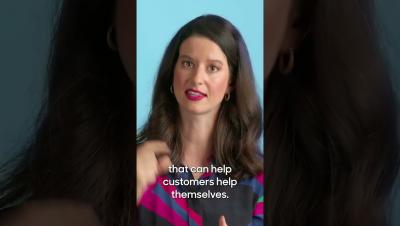Teams | Collaboration | Customer Service | Project Management
February 2023
Optimize your customer knowledge base - YT Shorts
Zendesk + Shopify: An eCommerce match made in heaven
Zendesk Customer Experience Trends 2023 - Conversational experiences | Conversations with Zendesk
Top retail trend to watch: Omnichannel CX
As shoppers trend towards becoming true omnichannel consumers, they’re opening both their real and virtual wallets. They expect the same personalisation and excellent service no matter where (or when) they shop. Retailers can deliver great omnichannel CX and reap the rewards.
5 digital banking customer experience trends to consider for 2023
Banks that consistently optimise the customer experience grow 3.2x faster than competitors that don’t. And with over 50% of consumers reporting that they’d switch to a competitor after a single unsatisfactory interaction, customer experience has never been more important for any industry. Here are some trends and best practices to help guide your CX strategy – and drive customer relationships that last.
From the Customer's lens: Order to cash - the Issue of integration in manufacturing
Many of the largest manufacturers have grown through acquisition, and this means bringing together so many different business processes, making the decision on what to consolidate, and what to keep separate, often challenging to say the least. Many manufacturing business processes– such as order to cash– weren’t originally intended to be joined up. That has often resulted in a lack of visibility around the pre-sales and post-sales experience.
Zendesk Customer Experience Trends 2023 - AI is Evolving #shorts
Choosing the best live chat customer service software for 2023 - YT Short
Zendesk Customer Experience Trends 2023 - AI is Evolving | Conversations with Zendesk
How AI can help manufacturers revamp their supply chains and be more sustainable
There has been plenty for the manufacturing industry to be concerned about in recent times. The ongoing effects of the pandemic and, more recently, the war in Ukraine have exposed supply chain vulnerabilities that are forcing companies to adapt quickly. Those who don’t, are faced with the unwelcome prospect of being unable to get their goods onto store shelves or being left with a costly overstock in their warehouses.
How to cold call - 5 effective cold calling tips that work
How upgrading and maintaining software can improve productivity
We all know that we should keep our apps and devices up to date. From adding features to fixing problems, updates help ensure that everything works as it should. Yet many businesses put off updating their software, often sticking with old systems until they fail. There are many reasons for this, including cost, time, fear of change, and that old chestnut: if it ain’t broke, don’t fix it.
9 ways AI can help you communicate better with your customers
From chatbots to intelligent routing systems, AI is transforming how companies communicate with customers. According to Servion Global Solutions, artificial intelligence (AI) is set to power 95 per cent of all customer interactions by 2025. And it’s not just businesses that love AI: Zendesk’s CX Trends Report 2022 revealed that two-thirds of customers approve of AI for making their lives easier, saving time, and improving their overall experience.
How CRM integrations strengthen your CRM solution
A recent MuleSoft survey found that the average business uses almost 900 different applications—but only 28 per cent of those applications are integrated. This means employees are wasting huge amounts of time switching between apps, searching for information, and entering data manually. But there’s a better way.
How to Calculate Customer Lifetime Value (CLV)
Calculating your customer lifetime value (CLV) can seem daunting. With so many different formulas and conflicting explanations, you might be unsure where to start or even confused about what exactly it measures. But don’t worry because we’re here to explain the ins and outs of this important metric. After all, measuring your CLV can help guide marketing spend, uncover marketing impact, and identify your most valuable customers.
Know it all with a chatbot for customer service
Chatbots are a great way for companies to keep up with growing customer expectations. As AI-powered solutions get more sophisticated, customers are more open to chatting with a bot. Indeed, Zendesk’s CX Trends 2022 Report found that 69 per cent of customers are willing to interact with a bot on simple issues. And with good reason. Bots are fast and responsive. Plus, it’s a lot easier to be there for your customers with a chatbot on your team.
Why product knowledge is essential in customer service
Excellent customer service depends on knowing what you’re selling like the back of your hand. Business Wire revealed that consumers rank “knowledge about the product or service” as one of the top qualities of customer service agents. Customers expect support agents to know everything there is to know about a company’s products and services. Simply reading out specs from a product information sheet won’t cut it.
How to track and improve your customer loyalty
Businesses need loyal customers. But gaining and maintaining customer loyalty is hard work. Zendesk’s CX Trends Report 2020 revealed that half of customers will leave after just one bad customer experience and 80 per cent will leave after multiple bad experiences. These scary numbers highlight just how important it is to stay on top of customer loyalty. But with so many metrics and so much data, it can be tricky to know where to start. If that sounds familiar, this article will help.
Let's get phygital: blurring online and IRL retail customer experiences
As shoppers trend towards becoming true omnichannel consumers, they’re opening both their real and virtual wallets. Consumers who blur the line between IRL and online shopping spend 70% more often – and about 34% more than people who shop exclusively in-store, according to McKinsey.























